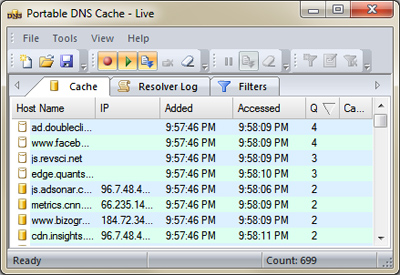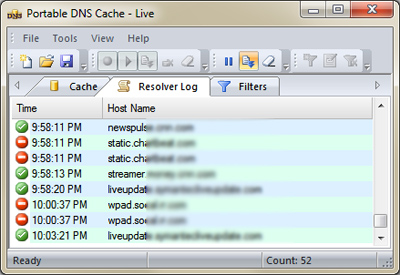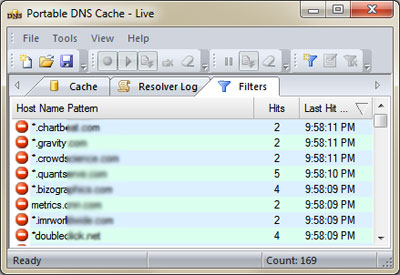Portable DNS Cache and Firewall
Technical Specifications
| Latest release |
3.2 ,
10 Jun 2016 ,
[Change Log]
|
|
Supported networking
|
Ethernet, IPv4, IPv6, TCP, UDP. |
| Prerequisites |
Up-to-date root certificates (otherwise, it will take
2 minutes to start).
|
| Supported OSes |
Windows 7*, 8, 8.1, 10, Server 2008 R2*, Server 2012, Server 2012 R2,
Server 2016.
*For Windows 2008 R2 and 7, required Service Pack 1 +
KB3033929 (SHA-2 digital signing).
|
| Recommended hardware |
1 GHz CPU or faster, modern graphics card. |
| Additional hardware required |
None |
Overview
DNS caching technology has taken another step forward with the release of Portable
DNS Cache. Now, cache records can be saved to a file and loaded upon request.
This software exposes the intricacies of communication between a computer and DNS
servers, monitors requests and responses, differentiates requests resolved locally
from those resolved via DNS servers, and blocks unwanted domain names
according to filtering patterns. The real-time monitoring and firewall capabilities
reveal the "secrets" of many programs that are
sneaking onto the Internet behind your back. The simplicity of the user interface
allows for quick and intuitive task performance. No configuration is needed — just
start it and see it all.
Domain Name System (DNS) Overview
[IT professionals can skip to the next section]
The DNS system has been in use for many years, serving as a foundation for
translating textual names (domain names) into the IP addresses that computers use
to communicate with each other.
When connecting to a website, popular Internet browsers like Internet Explorer,
Firefox, Mozilla, and Chrome first attempt to parse internet addresses into
several parts. One of these parts is a domain name, which is sent to DNS servers
to obtain the IP address of a server.
Even without an explicit request from a user, modern software often accesses the
Internet. Many users are unaware of such communication, as it occurs in the
background without user involvement or notifications. Examples of software with
automatic Internet access include desktop gadgets, applications with auto-update
capabilities, online backup software, time synchronization services, background
downloading software, file-sharing services, and the entire category of malicious
software.
Internet communication and browsing are not the only areas where DNS is used.
DNS name resolution is also frequently used on corporate networks to provide the
names of corporate file, print, and web servers to anyone who tries to access them.
The DNS resolution process often involves several stages. First, a computer
attempts to resolve a name via its local cache to save time and resources. Nearly
every computer has some form of DNS cache that holds recently resolved domain names.
This cache is stored on the local machine and is not available for transfer to
others. It is rarely viewed directly, even by IT professionals. This is one area
where Portable DNS Cache is particularly useful. It maintains the DNS cache,
displays its content, and resolves names from the cache instead of sending them to
a DNS server. Thus, even if a DNS server does not have a record for a domain name,
is actively blocking it, or has a different IP address for it, the IP address from
the cache will be used. Additionally, Portable DNS Cache makes it easy to delete
cached records or create filters from them to block or allow such domain names in
the future.
The next two stages in DNS communication are sending a request to a DNS server and
receiving a response. Using its firewall capabilities, Portable DNS Cache verifies
this communication. It blocks DNS requests or allows them to pass, depending on the
filtering rules created by the user. Whichever action is taken, a logging record
is created and displayed in the Resolver Log.
Many types of communication rely on DNS resolution in one way or another. That is
why it is important to be aware of ongoing DNS communication, as this holds the key
to detecting and stopping suspicious activity before it is too late. By blocking
DNS resolution, any further communication to that domain is essentially blocked.
It is very simple! If a computer does
not know the IP address of a domain name, it cannot connect to it!
Portable DNS Cache is designed to expose the DNS communication that occurs in the
background, provide portability for cached records, and block the resolution of
unwanted domain names.
Working with Portable DNS Cache and
Firewall
The user interface consists of control elements (menus and toolbars) and three
tabbed pages that provide different information about DNS communication.
The "Open" and "Save" file operations work on a single file. The data from the
Cache and Filters pages are loaded and stored together. Certain fields of items
from the Cache page (such as "Queries" and "Cache Responses") are cleared upon
loading.
Other operations allow you to change the theme of the user interface, place an
icon in the Windows system tray when minimized, and keep the window on top of
other windows.
Cache page
This page shows the records stored in the cache.

The icon
 next to a record indicates that a request for a DNS domain name has been issued,
but a response has not yet been received. Typically, a record remains in this
state for a short period between the request being sent and the reply being
received, with one exception: when a blocking filter is active for that domain
name. The icon
next to a record indicates that a request for a DNS domain name has been issued,
but a response has not yet been received. Typically, a record remains in this
state for a short period between the request being sent and the reply being
received, with one exception: when a blocking filter is active for that domain
name. The icon
 next to a record shows that it contains both a request and a response, and
Portable DNS Cache will use that data instead of sending requests to DNS servers.
next to a record shows that it contains both a request and a response, and
Portable DNS Cache will use that data instead of sending requests to DNS servers.
The Cache page includes several useful fields that help to better understand the
dynamics of cache population and resolution. The fields are as follows:
| Field name |
Description |
| Host Name |
The exact domain name from the DNS request. |
| IP |
The list of IP addresses from the DNS response. |
| Added |
The time when the record was first created. Essentially, this is the time
when the first request was made. For records loaded from a file, it contains
the time when the file was loaded.
|
| Accessed |
The time when the record was last accessed for DNS resolution. |
| Queries |
The number of queries since the record was created or loaded from a file.
|
| Cache Responses |
The number of responses that were taken from the cache instead of being
sent to DNS servers.
|
Whenever the Cache page is active, its toolbar is also active.
| Toolbar Button |
Description |
| Start/Stop recording into the cache |
When Recording is enabled, responses from DNS servers are stored in the cache.
|
| Enable/Disable Playback from the cache. |
When Playback is enabled, Portable DNS Cache can use cached records to
satisfy DNS requests without passing them to DNS servers. When Playback is
disabled, all DNS requests are passed directly to DNS servers, and the
received responses are forwarded to the programs that originated the requests.
|
| Clear cache |
Clears the entire cache. |
| Delete selected records |
Deletes the selected records. |
Resolver Log page
This page contains the log of DNS resolution activity. All activity is recorded
here. The log cannot be saved to a file.

The
 image denotes that the DNS request was blocked.
image denotes that the DNS request was blocked.
The
 image denotes that the DNS request was sent to a DNS server.
image denotes that the DNS request was sent to a DNS server.
The
 image denotes that the original DNS request was resolved by passing the request
to a DNS server and then forwarding the response from the DNS server back to the
program that issued it. In other words, it indicates that the request was not
resolved from the cache.
image denotes that the original DNS request was resolved by passing the request
to a DNS server and then forwarding the response from the DNS server back to the
program that issued it. In other words, it indicates that the request was not
resolved from the cache.
The
 image denotes that the original DNS request was resolved from the cache without
sending any data to a DNS server. This type of resolution saves time on data
travel between a computer and a DNS server.
image denotes that the original DNS request was resolved from the cache without
sending any data to a DNS server. This type of resolution saves time on data
travel between a computer and a DNS server.
The
 image denotes that the DNS server responded that it was unable to resolve the
domain name.
image denotes that the DNS server responded that it was unable to resolve the
domain name.
Whenever the Resolver Log page is active, its toolbar is also active. The toolbar
allows you to:
| Toolbar Button |
Description |
| Pause the Log |
Prevents new DNS activity items from appearing in the log.
|
| Clear the Log |
Clears all log entries. |
Filters page
This page contains filters that specify the rules for allowing or blocking
certain domain names. The firewall functionality of Portable DNS Cache uses these
rules to make real-time decisions.

Each filter has several attributes.
| Attribute |
Description |
| Host Name Pattern |
The pattern for domain name matching. It may include the '*'
(asterisk) symbol in various places, which denotes any number of any
characters.
|
| Apply when there is no match |
When checked, the filter action is executed for domain names that do NOT
match the Host Name Pattern.
|
| Action: Block |
Blocks the request. |
| Action: Never Block |
Prevents a domain name matching the pattern from being blocked by any other
rules. In other words, such a request will never be blocked.
|
| Enabled |
An Enabled/Disabled flag. Only enabled filters have an effect in determining
an action for a domain name.
|
Whenever the Filters page is active, its toolbar is also active and allows for the
creation of new filters and the editing of existing ones.
Tutorial Video
Notes:
* Windows® is a registered
trademark of the Microsoft Corporation.